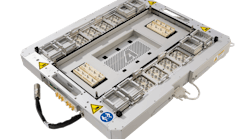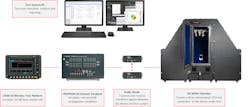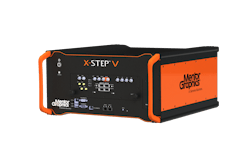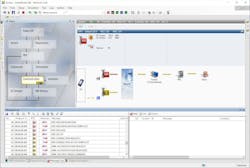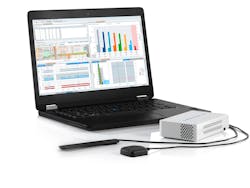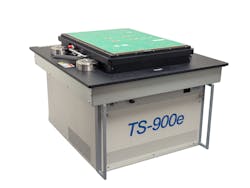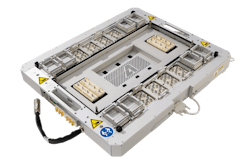Download this article in PDF format.
5G evolution is proceeding apace, with 3GPP Release 15 being deployed worldwide, Release 16 being frozen, and Release 17 under development. Whereas Release 15 focused on enhanced Mobile Broadband (eMBB), Release 16 addresses use cases such as the industrial IoT and C-V2X (cellular vehicle-to-everything). Release 17 will add support for non-terrestrial networks (NTNs) and extend FR2 (Frequency Range 2) frequencies to 71 GHz or higher. Keeping up with the rapidly-advancing technology will require flexible test equipment (extending from lab instruments and semiconductor test systems) as well as powerful software and simulation tools.
An array of 5G products
Keysight Technologies recently debuted several products that enable the development and rollout of 5G, according to Roger Nichols, 5G program manager. These products include advanced data analytics and machine-learning software for 5G base-station testing, which “…speeds the manufacturing process by allowing our customer…to use manufacturing data in a new way to reduce test time and optimize the test process,” Nichols said.
In addition, Keysight has introduced a 5G device benchmarking solution that allows customers to “grade” and troubleshoot devices based on an aggregated set of KPIs. “This is a unique combination of our NEMO Outdoor, UXM 5G Network Emulation, and Nemo 5G Device Analytics software,” Nichols said.
Nichols cited several other solutions Keysight has debuted, including O-RAN Studio O-RAN distributed unit (O-DU) emulation software, which enables validation of O-RAN-compliant radio units; LoadCore 5G core testing software, which simulates real-world use models to validate the performance of new 5G SA next-generation core networks from edge to cloud; the PathWave Design 2021 software suite, which brings an updated computer-aided automated design suite focused on FR2 and mmWave design issues from the system to the circuit to the component level; and Advanced Performance Test Toolset, which provides test capabilities for validating 5G device designs.
Nichols also said Keysight has obtained first approval from the 3rd Generation Partnership Project (3GPP) for 5G NR Protocol Test Cases for carrier aggregation. “We continue to lead the industry in the number of validated test cases for RF, RRM, protocol-conformance, and carrier-acceptance device test suites,” he said.
Alejandro Buritica, senior engineer, semiconductor systems R&D at NI, said the company has two new offerings that address 5G test. One is the new RF front-end validation architecture, featuring integrated, cockpit-like control and visualization of PA validation benches with the RFIC Test Software application. It enables users to easily configure power, frequency, and impedance sweeps, taking advantage of built-in control of Focus Microwaves tuners for validating PA performance under non-50-Ω conditions, he said. Users can also run linearization algorithms and compare linearized vs. non-linearized performance with detailed graphs and results for gain, AM/AM, AM/PM, EVM, ACLR, PAE, and loading conditions (Gamma and VSWR). Finally, users can deploy automated validation sequences, thanks to an automation wizard and a collection of ready-to-run code modules and test sequences.
The other new offering, Buritica said, is the mmWave OTA Reference Architecture, which will provide improved capability to include larger DUTs in test chambers and the ability to configure for either direct or indirect far-field (DFF/IFF) test.
According to Amr Haj-Omar, PhD., wireless market segment leader at Tektronix, the company’s products for 5G test include the 5G FR1 Solution for Tektronix’s 6 Series MSO and 6 Series low-profile digitizer. “Tektronix’s low-profile 6 Series oscilloscope/digitizer supports 5G FR1 requirements, as it covers all the spectrum up to 8 GHz with 2 GHz of instantaneous bandwidth with high resolution,” he said. “The unique architecture of these oscilloscopes introduces a DDC (digital down converter) within the sampling-system ASICs that creates a dedicated RF signal path. This allows the oscilloscope to easily analyze the frequency domain independently from the time domain and correlate between both the frequency and time domain. Spectrum-analysis controls are available through the touchscreen or remote interface. In addition, the 4-channel 6 Series enables parallel testing of MIMO devices.”
Tektronix released in September the new 6 Series B MSO, which comes with 6- and 8-channel models. “This is essential for testing 5G and Wi-Fi 6 due to their multi-antenna and transceiver designs,” Haj-Omar said. “Using SignalVu software in conjunction with the 6 Series oscilloscope enables testing of isolation and interference between adjacent channels with EVM and ACPR measurements.”
Haj-Omar also said the company’s DPO70000SX oscilloscope can support up to four channels at up to 70 GHz, which makes it suitable for 5G FR2 and MIMO test of beamforming RF front-end systems. “Similarly, it supports IEEE 802.11ay millimeter-wave applications,” he added. “The correlation between channels and its exceptional low phase noise make this oscilloscope a high-fidelity measurement tester, which can also support 6G THz applications with an external down-converter.”
“Overall RF testing is hard in 5G, so testing with digital interfaces (O-RAN and JESD204) makes it much easier to test all possible Release 16 and Release 17 cases with different kinds of existing and future antenna/frequency technologies and combinations,” Valasma said. “The O-RAN compatibility issues will continue to grow when more network slicing solutions are taken into use, and X-STEP can handle all possible scenarios.”
Anritsu is addressing 5G on several fronts. First, it has enhanced its SmartStudio NR (SSNR) MX800070A control software to support 5G-device Evolved Packet System (EPS) fallback tests using the Radio Communication Test Station MT8000A. With the new EPS fallback functionality, the MT8000A/SSNR environment simplifies evaluation and reduces cost-of-test when verifying 5G New Radio (NR) UE being developed for emerging applications. In addition, Anritsu added support for different radio-access technologies (RATs) within various deployments, such as non-standalone (NSA) and standalone (SA). “This is crucial as operators have begun to roll out SA in several markets,” commented Adnan Khan, senior manager, wireless and wireline market development.
According to Steve Dudkiewicz, vice president, marketing and business development at Maury Microwave, the company is seeing a growing demand for device characterization and modeling solutions above 28 GHz to support applications such as 5G FR2, automotive radar, and next-generation semiconductor technology evaluation. “These applications are not only driving frequencies higher, but are also pushing the envelope on modulation bandwidths,” he said. “To address these challenges, our state-of-the-art semiconductor test solutions push the boundaries of load pull with extreme modulation bandwidths, as well as expanded frequency coverage to 1.1 THz.”
Dudkiewicz added that 5G will unlock new levels of mobile communication performance with high speeds, low latencies, and ultrahigh reliability—enabled in part by the FR2 frequency bands around 28 GHz and 38 GHz, with channel bandwidths in the hundreds of MHz. “These bandwidths pose a challenge for passive impedance tuners, where the phase variation over frequency results in the loss of impedance control and degrades ACPR, EVM, and PAE performance when using wideband modulated signals,” he said. “To overcome this challenge, we designed the MT2000 mixed-signal active load pull system, which corrects for impedance phase variations and allows users to set arbitrary impedances over a bandwidth of up to 1,000 MHz at frequencies up to 40 GHz. With wideband impedance control, we can now synthesize the load conditions presented by realistic matching networks and antennas and accurately characterize the vector-corrected performance of a DUT.”
To achieve this capability, he said, “We designed the MT2000 from the ground up as a standalone one-box solution, which replaces the functions of a vector network analyzer, vector signal generator, vector signal analyzer, and automated impedance tuners, thereby reducing the overall system cost and complexity while simultaneously ensuring an excellent measurement accuracy.” Additional features include high-speed CW and pulsed-CW measurement capability, baseband impedance control, time-domain nonlinear analysis, behavioral model extraction for 5G circuit design, and I/Os for digital predistortion and envelope tracking tests, he added.
“At LitePoint, we are focused on helping customers characterize their products and bring them to high volume manufacturing,” according to Adam Smith, director of marketing at LitePoint. For 5G product test, the company offers IQxstream-5G for FR1 (sub-6-GHz) and IQgig-5G for FR2 (mmWave).
“IQgig-5G is our second-generation 5G mmWave product focused on scaling 5G mmWave FR2 end products to high-volume manufacturing,” Smith said. “Unique in the industry, the IQgig-5G is the only fully integrated mmWave test system in the market and is deployed in the manufacturing testing of multiple devices in parallel, enabling product companies to lower their manufacturing costs.”
Smith described IQxstream-5G as a fully-integrated test solution for FR1 products, specifically addressing PCB-level calibration and verification. “Calibration is an essential part of the manufacturing process,” he said. “This is key to ensuring that products deployed on carrier networks will deliver a quality user experience and also not interfere with other devices, which would reduce the capacity of the network. IQxstream-5G delivers the industry’s best measurement accuracy for calibration and uniquely includes 200 MHz of instantaneous bandwidth and integrated MIMO technology.”
Rohde & Schwarz has been addressing increased public interest in human exposure to electromagnetic fields. The company develops and provides test and measurement products that help to ensure that exposure is below a certain threshold defined by authorities and local regulators, according to Andreas Roessler, technology manager at Rohde & Schwarz USA. “As a company, we follow here the guidelines set by the International Commission on Non-Ionizing Radiation Protection (ICNIRP), which defines several measurement principles, based on frequency range and exposure time,” he said. “5G NR defines a very flexible air interface and is using beamforming techniques by default, which makes the EMF measurements more challenging and complex.”
Many regulators require a measurement of the EMF exposure per radio access technology, thereby requiring more sophisticated methods than a single spectrum scan, Roessler explained. “Due to those enhanced requirements, we now also offer EMF measurement capabilities embedded in our test solutions for network optimization and benchmarking,” he said. “The R&S TSME6 universal network scanner, in conjunction with the ROMES drive test software, now allows EMF measurements based on 5G NR signal components, like the ‘always-on’ synchronization signal blocks (SSB). Any service provider can now, while doing network optimization, also measure the current exposure to electromagnetic fields.”
Simulation
MathWorks provides a suite of tools for 5G design and test, according to Dr. John Wang, principal wireless industry manager. He cited two capabilities that are particularly useful for 5G test: 5G waveform generation and connectivity to SDR hardware and RF instruments.
“Let’s start with a closer look at the first capability,” Wang said. “MathWorks products include a waveform generation app that can generate standard-compliant 5G waveforms in addition to several other standard waveforms (LTE, WLAN, etc.). This app boosts productivity for RF test engineers because it makes all the options on an RF instrument available in the graphical interface.” He noted that while MathWorks has had the ability to generate waveforms programmatically for years, the new app can supply a real signal generator with standard-compliant 5G signals, with the generated waveforms used over the air, with test and measurement instruments from various hardware vendors.
“We currently support NR test models (NR-TM) and 5G NR uplink, downlink fixed reference channels (FRC) for 5G, and we are working on expanding these to fully flexible waveforms,” Wang said. “You can distort the waveform by adding RF impairments such as additive white gaussian noise (AWGN), phase offset, frequency offset, DC offset, IQ imbalance, and memoryless cubic nonlinearity. For RF engineers who like to interact with the instrument, they can have a similar experience visualizing the waveform in the constellation diagram, spectrum analyzer, OFDM grid, and time scope plots and export the waveform to different file formats.”
The second key capability—connectivity to software-defined radio (SDR) hardware and RF instruments—allows test engineers to use MATLAB and Simulink to perform over-the-air tests to validate 5G designs in simulation, in the lab, or in the field under real-world conditions, according to Wang. “The test benches, signal generators, scopes, and measurements used at the simulation stage can be reused for hardware testing,” he said. “This approach eliminates the need to recreate tests in a different software environment, and reduces test development time and errors.”
Semiconductor test
System software includes a suite of digital and parametric test capabilities as well as SPI/I2C interface support for controlling and monitoring the DUT. DIOEasy supports digital waveform editing/display, ICEasy supports device test development, and the company’s ATEasy integrated development environment (IDE) and test executive allows users to quickly develop and maintain test applications, Semancik said, adding that the receiver interface is compatible with Opus 3 and TEL probe stations as well as Seiko Epson E8040 and E8080 device handlers.
“The TS-900e-5G is an open-architecture PXIe-based design providing exceptional flexibility, maintainability, and forward-looking adaptability,” Semancik said. “Instrumentation can easily be upgraded to comply with the latest specification releases, further enhancing the utility of the test system.”
“Advantest has recently introduced its Wave Scale Millimeter solution to the market, which is a modular, flexible, and scalable hybrid mmWave solution, which makes it one of a kind in the industry,” according to Adrian Kwan, senior business development manager, adding that its features help customers keep pace with 5G evolution. Release 16 defines additional 48.2-GHz and 52.6-GHz 5G bands with bandwidths up to 2 GHz, Kwan explained, adding, “The Advantest mmWave solution allows quick adaptation for technology changes in the industry standards.” As for Release 17, Kwan said, “I anticipate frequency extension beyond 52.6 GHz and an integration between 5G and Wi-Gig bands working seamlessly.” As for specific initiatives, Kwan added, “We have recently worked with universities to successfully patent 5G over-the-air test technology.”
According to Jeorge Hurtarte, wireless product marketing strategist at Teradyne, the company offers the UltraWaveMX44 for 5G NR mmWave frequencies to 44 GHz. “With the UltraWaveMX44, customers can easily upgrade by adding an additional instrument to their tester head and get a fully calibrated millimeter-wave instrument,” he said. “There is no need for customers to add additional millimeter-wave circuitry in their DIB…. The UltraWaveMX44 allows them to quickly go to market and worry only about testing the part rather than worrying about instrumentation.”
Hurtarte said competitive approaches add a layer of circuitry between the DUT and the internal instrument—a “middle layer” that sits on top of the test head. “That's an additional mechanical enclosure with mmWave circuitry,” he explained. “On top of that layer comes the DIB to the DUT. By having that additional layer outside of tester head, that means multiple sets of signal delivery cabling. The test process includes the tester head to the middle layer to the DUT. When you have multiple signal delivery layers, that is more complicated, and it becomes more difficult to maintain calibration accuracy. Teradyne has fully eliminated that middle layer, making test simpler.” He added that Teradyne continues to monitor for any new spectrum in the mmWave space.
Other companies are developing components that can find use in 5G test instruments and ATE. For example, Menlo Micro is developing several products based on its MM5130 “Ideal Switch” that are well-positioned for the demanding requirements required for 5G test applications, according to Jonathan Leitner, RF product marketing engineer. “Three examples are switch-based products that address the RF and microwave test markets,” he said. “The first is a coaxial SPDT switch, the second an integrated DPDT switch module, and the third is a compact PXI-based switch matrix.” These products, he added, will target emerging RF and microwave single-ended and differential components and system-test applications involving probing, DIBs, ATE, and test and measurement equipment. “All three will have some key advantages over traditional solid-state and relay technologies by taking advantage of the switch design’s inherently low insertion loss, very high linearity, and extreme reliability,” he said.
Leitner said Release 16 is opening up applications from V2x to satellite to advanced IIoT, with a push to support higher frequency bands and channel bandwidths. The MM5130 operates past 20 GHz, with a roadmap to support mmWave frequencies and a product portfolio beyond just switches, he said. “Menlo has leveraged the Ideal Switch technology to build RF subsystems such as filters, phase shifters, RF switch matrices, and more,” he commented. “All of these operate with low RF losses and at very high linearity, and therefore RF systems can now target and operate with greater dynamic range, operate more efficiently, and at lower power levels. The results can be simplified test setups with higher performance at a lower cost.”
Looking ahead, “We see a continuing push towards massive MIMO and highly integrated beam-steering antennas to address emerging 5G infrastructure systems,” Leitner said. “Menlo has developed a compact and scalable delay-line phase shifter driving a 3.5-GHz CBRS-band beam-steering antenna.” Unlike traditionally large infrastructure antennas using motorized mechanical phase shifters to control the beam pattern and down tilt, he said, this phase shifter is entirely electronically controlled. The core is the MM5130 switch, with 85-dBm IP3 and 0.2-dB insertion loss, which results in a smaller phase shifter and a more integrated antenna that better meet the requirements for emerging 5G small and microcell radios, he explained.
And finally, “Molex is fully invested in 5G research and development,” according to Stephen Drinan, director, core products. “We utilize the latest, high-frequency testing chambers. Seeing the growing need for 5G testing, we have been early adopters of 5G testing equipment with the implementation of an in-house testing operation.” He added that Molex offers product design and system manufacturing expertise that enables design engineers to create 5G products suitable for mass production. “The need and demand for 5G testing is very high,” he said. “Extreme care and expertise are required for 5G testing, causing the testing lead times to grow exponentially. Molex already serves the 5G market with a number of antennas and high-speed board-to-board connectors and continues to grow these product lines.”
Several subject-matter experts who contributed to this report elaborated on the implications of 3GPP releases 15, 16, and 17 as well as the cooperative efforts needed to drive 5G technology forward. A subsequent article will discuss their responses in detail.
